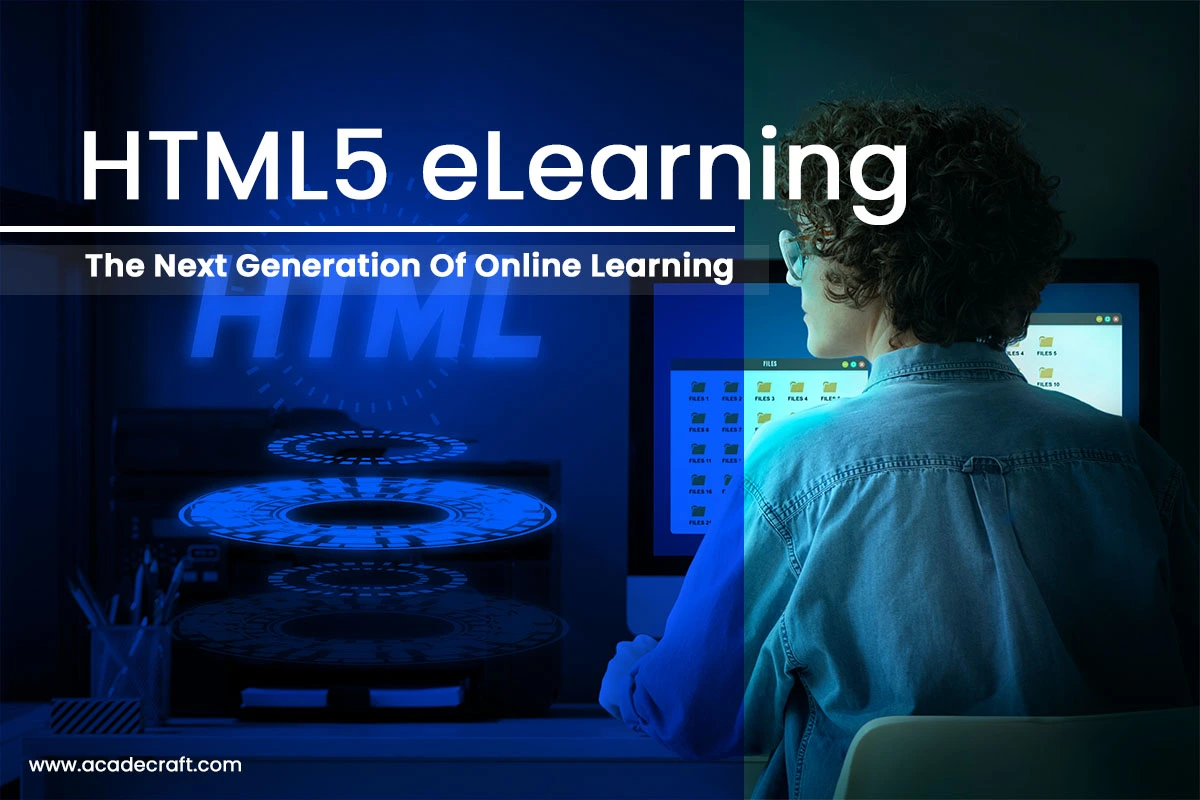
Have you ever tried accessing a website or educational materials through your device only to notice that they display oddly? It is not only frustrating but also reduces comprehension of the content.
However, responsive eLearning solves this by ensuring that learning programs appear splendid on every screen size or gadget. It implies that accessing educational resources and web pages on every device becomes effortless and visually appealing.
The responsive design depends upon HTML5 as its foundation, allowing various web page elements to work hand in hand together without requiring additional plugins. Using HTML5, you can customize your content to take full advantage of multi-device functionality.
A dependable, responsive authoring tool should support HTML5 coding, though there is no need to worry about complex coding as it can handle it for you. In this blog, you will learn everything about HTML5 eLearning.
It is a markup language that is used to create web pages. It is the successor to HTML4 and is designed to be more flexible and powerful. HTML5 includes multiple features that make it ideal for eLearning, such as support for accessibility, multimedia, and interactivity.
Responsive eLearning Courses:The courses designed to access from any device without breaking code, content, or images are known as responsive eLearning courses. It's easy to create responsive online training courses with HTML5, and these eLearning Courses are designed to adapt to the screen size they are being viewed on. It makes it ideal for learners using various devices, like smartphones, tablets, desktops, and laptops.
HTML5 is the latest and most wonderful standard for creating eLearning courses. It offers advantages over previous standards, including greater accessibility, flexibility, and interactivity.
There are multiple benefits to using HTML5 eLearning, a few of them are listed below:
Before HTML5, Flash (a format for developing online courses before HTML5 was introduced) required students to download plug-ins to access the course materials. The need to download the correct version to view learning content made plug-ins problematic for learners.
HTML5 solves this problem by enabling users to have direct access to learning content created with this technology from any web browser. By learning HTML5 code, all commonly used web browsers, including Chrome, Internet Explorer, Firefox, Safari, and Opera, can deliver educational content to mobile devices.
The eLearning courses can be developed and delivered more cost-effectively than traditional ones, as they can be accessed on any device with a web browser, eliminating the need to create separate versions of the course for multiple devices.
According to a study by Brandon-Hall, Online learning requires 40-60% less employee time than a classroom because it can be performed asynchronously.
Responsive eLearning courses can be easily updated and revised, allowing for ongoing improvements without incurring additional costs.
Utilizing responsive eLearning courses is a highly effective strategy for achieving scalability as they can effortlessly adapt to meet the needs of the fastest-growing audience.
As the number of students or learners increases, the course can be easily adapted to adapt more devices and screen sizes. For instance, responsive eLearning courses can easily be adapted to accommodate a growing audience, from small classrooms to massive online courses with hundreds of thousands of students.
It allows organizations to reach more users while maintaining a consistent user experience across different platforms. It also eliminates the need for costly, lengthy redesigns when the audience grows.
HTML5 responsive eLearning courses are more flexible than traditional courses in various ways.
For example, learners could take a Digital Marketing Course on their laptop at an institution and continue working on the course on their tablet when they get home. This flexibility was impossible with traditional courses, often designed to be viewed on a specific device.
Interesting Read: Top 10 Benefits of LMS to Deliver Online Training
The digital responsive courses are interactive as it allows students and learners to interact with the content. It is because of multimedia elements like audio, video, and animations. For instance, a learner could watch a video about the latest product, listen to an audio recording of a lecture, or interact with an animation that explains a concept. This way, interactivity helps learners understand the content and allows them to engage.
Some common examples of how HTML5 can be used to improve the interactivity of eLearning courses:
These benefits can improve learner engagement and boost outcomes while fulfilling the goals.
According to research, the worldwide e-learning market is projected to reach USD 648.6 billion by 2030.
Let us imagine a world where eLearning courses are not limited by the device on which they are viewed and can be accessed on any device regardless of screen size or resolution. Moreover, the courses are visually appealing and engaging as they are informative.
A few creative examples of how responsive eLearning courses could be used in the future are as follow:
Bonus Read: How to Use Gamification to Boost Performance and Productivity
Responsive eLearning solutions can assist in making courses that can be used in various ways to improve learners' learning experience. For example, they can be used to:
As more and more learners access eLearning courses on mobile devices, the demand for responsive eLearning courses will continue to grow. HTML5 eLearning is an excellent standard for creating responsive eLearning courses and its future of learning.
This article has covered various benefits of traditional eLearning courses, including accessibility, cost-effectiveness, scalability, flexibility, and interactivity. As a result of these benefits, HTML5-responsive eLearning courses are becoming increasingly popular in delivering training and education to employees and learners. If you are considering developing an eLearning course, HTML5 is a great option. Moreover, you can also benefit from our custom eLearning development services that are robust, cost-effective, and secure.
References:
Share